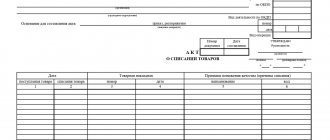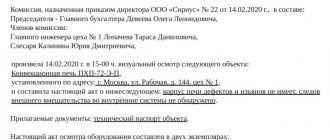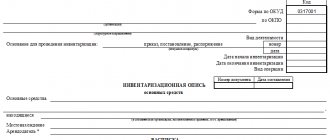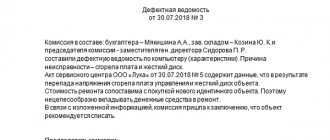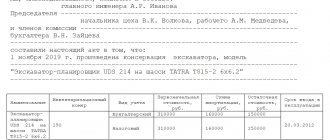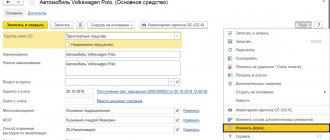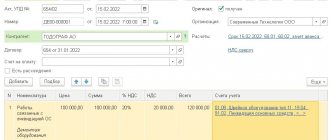Who is involved in the acceptance and delivery
In order to record the movement of fixed assets from the contractor to the customer after repair/modernization/reconstruction, a special commission is created in the company. It consists of enterprise employees from different structural divisions - as a rule, technical specialists, an employee of the accounting department and a management representative.
The commission’s task is to make sure that all the necessary work has been carried out at the proper level and the facility is suitable for further use.
Who uses OS-3 and for what?
If fixed assets in an organization have been repaired, reconstructed or modernized, this should be recorded in a primary document.
To record restoration operations, a special form is used - Act OS-3 (Decree of the State Statistics Committee No. 7 of January 21, 2003). Like other registers from the albums of unified forms, OS-3 is not required. Since 2013, organizations have the right to independently develop a primary document, including mandatory details in the document (Part 2 of Article 9 402-FZ of December 6, 2011). Your own form must be fixed in the accounting policy. IMPORTANT!
The act is used for the acceptance of repaired fixed assets and finished objects after reconstruction and modernization. After it is signed, the OS is put into operation. All information about the repair work performed is recorded in the inventory card. Typically, the unified form OS-6 is used for inventory accounting of fixed assets.
The readiness of the facility for commissioning is determined by a special commission. The acceptance committee is formed from company employees; they represent different structural divisions. There are no special rules for organizing the commission, but it usually includes a technical specialist, an accounting employee and a representative of the administration (management). Members of the commission study the list of works, check the fixed asset and confirm its suitability for use in the enterprise.
Use free instructions from ConsultantPlus experts to correctly take into account the modernization, completion, and retrofitting of OS in tax accounting.
Features of the act, general points
If you have been given the task of creating an act of acceptance and delivery of a fixed asset that has undergone repair work, and you do not know exactly how to do this, carefully read the recommendations below. Look at the example of filling it out - you can easily draw up your document based on it.
Before moving on to a detailed description of the act, we provide general information about the document. Let's start with the fact that today there is no single unified model (the abolition of mandatory forms of primary documents occurred in 2013). This means that an act can be formed in any form or according to a template approved in the accounting policy of the enterprise.
However, the option of using the previously generally applicable OS-3 form is in greatest demand - it is convenient in structure, understandable and contains all the necessary information.
In this case, the method of drawing up the act must be reflected in the company’s regulatory documents.
Form OS-3 can be filled out by hand or on a computer - however, if the second path is chosen, the form should be printed after final formation. This is necessary so that all parties involved in the acceptance and delivery of fixed assets can put their signatures on the document, including those directly involved in the acceptance and delivery, the chief accountant and the director of the enterprise.
It is not necessary to certify the form with a seal - this should only be done when such a condition is in the company’s local documentation.
An act is drawn up in at least three copies (if the act is filled out by hand, then using a copy sheet) - one for each of the interested parties. If necessary, additional copies can be made, which also need to be properly certified.
Features of filling out the OS-3 form
Below we note the main points that you should pay attention to when filling out OS-3:
- This document must be drawn up on the day the property is received.
- A higher commission inspects the OS and conducts a fact check.
- The finished data is indicated in OS-3, upon completion of which a conclusion is created about the state of the OS.
- Certification of the act is carried out by all members of the commission.
Which people must certify Form OS-3?
- Participants of the handing over and the side that accepts it.
- Chief accountant of the customer.
- Management company.
If this document is drawn up for another company, then it is necessary to make 2 copies of the document, providing it to the accounting department and the contractor.
Sample act of acceptance and delivery of repaired fixed assets
At the beginning of the document, on its front side, the following is indicated:
- details of the organization that owns the fixed assets: its full name, the structural unit to which the object is assigned;
- information about the company that carried out the restoration work.
On the right side of the form the following is entered in the plate:
- OKPO codes of both enterprises;
- information about the contract (number, date of conclusion);
- repair period (contractual and real);
- number assigned to the act;
- date of formation of the act (remember that the act must be drawn up directly on the day of return of fixed assets to the owner).
Below on the right are several lines for approval of the completed form by the head of the organization, and then there is the first table. It contains information about the condition of the object at the time it was sent for repair:
- its serial number and name are indicated;
- inventory, passport and serial numbers;
- price and actual period of use.
After this, you need to fill out another table, which concerns the financial costs incurred by the owner of the repair. Here it is indicated:
- serial number and name of the object;
- the type of work to which he was subjected;
- dismantling costs (if any);
- cost of work under the contract and real;
- Notes – these are provided as needed.
The table summarizes the results: the price of the fixed asset after repair and restoration is entered in writing here.
On the reverse side of the form is a summary of the commission that was present at the acceptance and delivery of the reconstructed materials. It indicates how completely the work was completed, its type (repair, reconstruction or modernization), changes that were recorded as a result of the restoration manipulations performed.
Then the form is signed by all members of the commission, as well as by persons directly involved in the process of acceptance and delivery of material and by the management of the company.
How to fill out OS-3
The transfer and acceptance certificate of repaired fixed assets is drawn up in a unified form or on its own letterhead. It consists of two sections:
- Information about the condition of objects at the time of transfer for repair, reconstruction, modernization.
- Information on the costs of repair, reconstruction, modernization.
After filling out these sections, the acceptance committee gives an opinion on the object: assesses its actual condition and determines its suitability for use. If the organization is not a VAT payer or uses the repaired object in operations not subject to value added tax, the cost of the work including VAT should be reflected in the act.
Instructions on how to fill out an act in form OS-3:
- Design a hat. Enter the name of the organization and structural units that are involved in the operation.
- Enter OKPO in the code line for each structural unit.
- Indicate the number and date of the contract (order) for repairs. Determine the planned and actual dates for repairs, reconstruction, and modernization.
- Enter the number and date of completion of the act.
- Confirm with the manager.
- Complete the first section. In the table, indicate the serial number, name of the object and its inventory number, details of the fixed asset passport and serial number, replacement cost. Separately note the actual service life of the asset.
- Complete the second section. In this table, enter the serial number, name of the object, type of work done, dismantling costs, cost of work performed under the contract, actual cost of repair, reconstruction or modernization, transportation costs and, if necessary, notes.
- Enter the cost of the fixed assets after the work has been completed.
- Fill out the commission's conclusion.
If the organization carried out the repairs itself, then OS-3 is issued in one copy. If it was necessary to involve a contractor for the work, then the act is drawn up in two copies: one copy for the customer (transferred to the accounting department), the other for the contractor. The completed OS-3 form is signed by all members of the commission, a representative of the unit that commissioned the facility, and a representative of the unit (enterprise) that performed the work. In addition, the chief accountant signs the act.
How to account and store a document
The act in form OS-3 is subject to mandatory recording and storage. Information about the completed, signed and approved form must be entered into the internal documentation journal, indicating the date of creation and document number.
After this, the form should be placed in a folder with other similar papers, where it should be kept for the period established by law or for the period prescribed in the internal regulations of the organization. After this time, it can be disposed of following the procedure specified by law.
Who applies and when?
The date of acceptance of the fixed asset by the special commission is the date of execution of the act, form OS-3.
Its members inspect the repaired, reconstructed or modernized facility, checking the operational attributes and functions, and their performance.
The results of the actions taken and the final condition of the property are stated in the act.
The authenticity of the recorded information is confirmed by the signature of all representatives of the commission.
Filling out when accepting delivery of repaired, reconstructed, modernized OS facilities
The form consists of 2 blocks:
- data on the fixed asset as of the date of its transfer for reconstruction;
- information about the company’s costs for repair work.
The header of the act, form OS-3, contains: the name of the customer and the direct performer of the work, OKUD and OKPO codes.
The details of the contract (order for repair, reconstruction or modernization) and the date of actual and actual reconstruction of the property are also filled in here.
The main block of the document consists of 2 tables, the first of which contains the initial properties and functions of the object (before modernization) and includes 7 columns: serial number, name of the fixed asset, inventory number of the object, number of the property passport and factory, restoration the cost of the fixed asset, the period (actual) of use of the object.
The following table has 10 columns and includes the following information:
- serial number;
- name of the fixed asset;
- type of work performed;
- repair costs;
- the cost of work under the repair contract and their actual cost;
- fare;
- notes.
The cost of the fixed asset after the modernization (repair, reconstruction) is indicated in a separate line under the table.
The reverse side of the OS-3 form contains the conclusion of the commission, the completeness of the work carried out, and specific changes in the characteristics of the object after the measures taken.
Members of the commission carefully inspect and check repaired or modernized fixed assets, and then attest to the technical condition of the facility.
The completed OS-3 act is signed by:
- all members of the commission;
- representative of the enterprise, the renting party and the receiving party;
- Chief Accountant.
When carrying out repairs at your own enterprise (without involving third-party companies), the OS-3 act is drawn up in a single copy.
If other organizations are involved in the repair, then the form is drawn up in 2 copies (for the receiver and the contractor).
When an organization enters into a contract with a contractor and engages a transport company to transport property, the form is filled out in 3 copies, one for each party.
The completed document is approved by the head of the company or his representative vested with appropriate authority.
Information about repairs or reconstruction is recorded in the inventory card of the fixed asset (form OS-6).
Features of filling out the form:
- drawing up a document on the day the repair is completed;
- fixation of reconstruction deadlines (contractual and actual);
- The time of preservation of objects is not taken into account if depreciation transfers have been completed.
Upon completion of entering data into the table, the commission notes the degree of completion of the work, based on the terms of the contract.
If not all clauses of the contract are met, then the text must indicate all the work that was not carried out.
After the act is signed by the head of the enterprise, it is sent to the accounting department, where the entered information is checked and cost accounting entries are made.
The accountant puts a mark on the work done on the card (according to form OS-6 or OS-6b).
Download free form and sample in excel and word
act on acceptance of delivery of repaired, reconstructed or modernized facilities, form OS-3 – excel, word.
filling out the OS-3 act – excel.


